5 Common Seated Row Mistakes
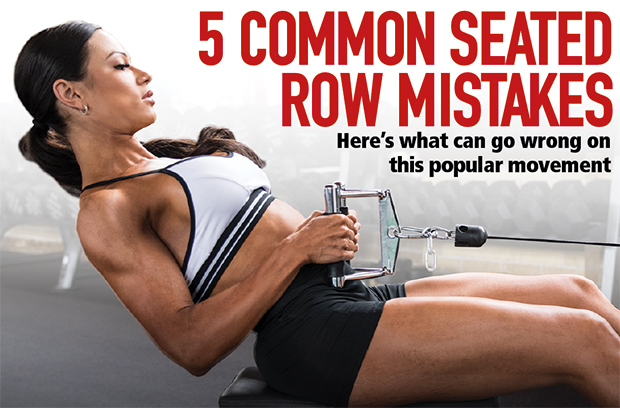
Here’s what can (and often does) go wrong on this popular rowing movement
The various mistakes you can make on a single back-training exercise are likely the same ones you make on the others as well. Here, we’ll take a common rowing exercise, the seated cable row—in which you pull more or less perpendicular to your body, which is ideal for building middle-back thickness—and fix those blunders. You’d be amiss if you didn’t apply those same lessons to other rowing exercises as well, meaning you’ll get a lot more bang for your buck when your next back workout comes around. Here’s what’s commonly done wrong and what to look for.
1. LEANING BACK AS YOU PULL
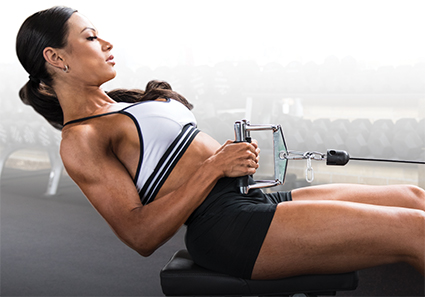 Whether doing rows or pull-downs, it’s common to see bodybuilders seesawing their bodies in an effort to move weights that are simply too heavy. That motion adds the lower back (movement at the hip joint) into this lat/mid-trap/rhomboid/rear delt exercise (in which only the elbow and shoulder joints should be involved). This completely defeats the purpose because recruiting the former reduces the tension on the latter. Swallow your pride and lessen the weight a few plates. It’s okay to bend forward or backward about 10 degrees, but anything more reduces the emphasis on the target muscle and increases your risk of injury.
Whether doing rows or pull-downs, it’s common to see bodybuilders seesawing their bodies in an effort to move weights that are simply too heavy. That motion adds the lower back (movement at the hip joint) into this lat/mid-trap/rhomboid/rear delt exercise (in which only the elbow and shoulder joints should be involved). This completely defeats the purpose because recruiting the former reduces the tension on the latter. Swallow your pride and lessen the weight a few plates. It’s okay to bend forward or backward about 10 degrees, but anything more reduces the emphasis on the target muscle and increases your risk of injury.
2. ROUNDING YOUR BACK
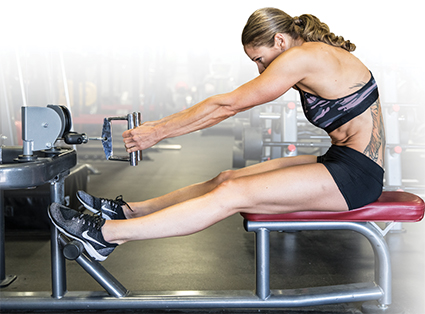 This is one you probably hear more than any other, and for good reason: When your back rounds, it puts the discs in your spine, especially the lumbar (lower back) and thoracis (mid-back) areas, under tremendous pressure and increases the likelihood of an injury. Disc herniation is one of the worst injuries a bodybuilder can suffer because it can cause long-term pain, atrophy, numbness, or even a disabled nerve connection, meaning that a muscle can no longer contract. Whether you’re pulling down, pulling up, pulling over or rowing, your entire body has to be in ideal position not only for growth and strength gains but also for safety. For spinal health, keep your chest big and your lower/mid-back arched—never rounded. That means your core muscles have to be contracting isometrically to maintain your body position so that your back doesn’t round, especially toward the end of your set.
This is one you probably hear more than any other, and for good reason: When your back rounds, it puts the discs in your spine, especially the lumbar (lower back) and thoracis (mid-back) areas, under tremendous pressure and increases the likelihood of an injury. Disc herniation is one of the worst injuries a bodybuilder can suffer because it can cause long-term pain, atrophy, numbness, or even a disabled nerve connection, meaning that a muscle can no longer contract. Whether you’re pulling down, pulling up, pulling over or rowing, your entire body has to be in ideal position not only for growth and strength gains but also for safety. For spinal health, keep your chest big and your lower/mid-back arched—never rounded. That means your core muscles have to be contracting isometrically to maintain your body position so that your back doesn’t round, especially toward the end of your set.
3. FAILING TO PULL YOUR ELBOWS BACK
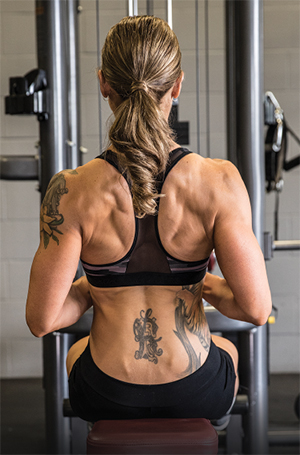 You’d never dream of loading up the squat bar and going down just a few inches (we hope!), but that’s effectively what’s happening when you’re rowing with too much weight. For a full contraction, you need to pull your elbows behind the plane of your back as far as possible, retracting your shoulder blades (pinching them together) as you squeeze the target muscle. Going too heavy limits the range of motion, a very common mistake.
You’d never dream of loading up the squat bar and going down just a few inches (we hope!), but that’s effectively what’s happening when you’re rowing with too much weight. For a full contraction, you need to pull your elbows behind the plane of your back as far as possible, retracting your shoulder blades (pinching them together) as you squeeze the target muscle. Going too heavy limits the range of motion, a very common mistake.
4. ALWAYS USING THE SAME HANDLE
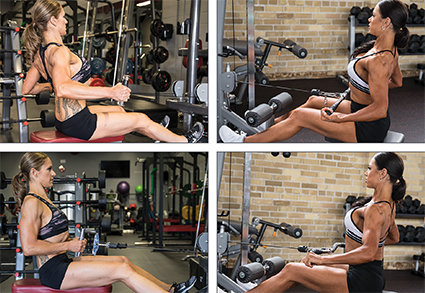 For years and years, I used only the close-grip handle, not realizing other handles (via alternative hand positions) incurred slightly different muscle-recruitment patterns. Here’s what to watch for, according to exercise scientist and author Jim Stoppani, PhD: “Taking a wide grip (outside shoulder width) [on rowing exercises] and pulling the bar or handle to a higher point on your chest targets the upper latissimus muscles while also training the rhomboids and middle trapezius. Using a narrow grip (the hands shoulder width or closer), especially when using a reverse grip and pulling the bar or handle to your lower abdominals, emphasizes the lower latissimus dorsi.” In a nutshell, use a variety of grips for better overall development or to target a weak area.
For years and years, I used only the close-grip handle, not realizing other handles (via alternative hand positions) incurred slightly different muscle-recruitment patterns. Here’s what to watch for, according to exercise scientist and author Jim Stoppani, PhD: “Taking a wide grip (outside shoulder width) [on rowing exercises] and pulling the bar or handle to a higher point on your chest targets the upper latissimus muscles while also training the rhomboids and middle trapezius. Using a narrow grip (the hands shoulder width or closer), especially when using a reverse grip and pulling the bar or handle to your lower abdominals, emphasizes the lower latissimus dorsi.” In a nutshell, use a variety of grips for better overall development or to target a weak area.
5. NOT DROPPING YOUR SHOULDER BLADES
 The evidence is only anecdotal, but I worked with Florida exercise scientist Christopher Barakat, MS, and, experimenting with electromyography (EMG), determined that dropping your shoulders (scientifically, depressing your scapulae) as you initiate the rowing movement tremendously increases upper lat activation. His advice: “Picture yourself trying to scrape your elbows across the floor as you’re rowing.” It may be worth a try!
The evidence is only anecdotal, but I worked with Florida exercise scientist Christopher Barakat, MS, and, experimenting with electromyography (EMG), determined that dropping your shoulders (scientifically, depressing your scapulae) as you initiate the rowing movement tremendously increases upper lat activation. His advice: “Picture yourself trying to scrape your elbows across the floor as you’re rowing.” It may be worth a try!
Get articles like this one delivered to your email each month by signing up for Muscle Insider’s mailing list. Just click here.

